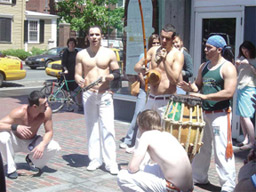BY JANE WENContributing Writer
Capoeira is a Brazilian martial art, most commonly described as a mixture between break dancing and kickboxing, coming to UMass Boston this fall.
Nim “Pontera” DePaz from Capoeira Brasil-Boston will be teaching classes at the Beacon Fitness Center. Capoeira Brasil is the second largest capoeira group in the world, with over 35,000 members in 10 different countries. Capoeira has been involved in the making of movies such as Cat Woman, Only the Strong, etc, and has been in video games like Street Fighter, and even in one of The Artist Formerly Known As Prince’s music videos. Pontera is currently teaching classes in Brighton and Cambridge and his students only have great things to say about his teaching, style, and great sense of humor.
“It’s a lot of things put together into one art that includes self defense, attack, history, ritual, language, music, and rhythm,” Pontera says. “It is a family, a great way to get in shape as it is different from any other art…it is different arts combined into one.” The most important aspect is that, “Capoeira Brasil is a family, everywhere you go, you will have somewhere to stay.”
Anacleto Assis (a.k.a. “Caveira”), the leader of Capoeira Brasil Boston says, “Capoeira is everything. Capoeira is my life, everything the mouth eats, my drink, my food, my love, and my philosophy of life. I don’t know what to do without Capoeira, I think I’ll die.”
Rodridgo Rangel a.k.a. “Maluco” added behind Caveira “Capoeira will resurrect me after I die.” Caveira recommends Pontera as a teacher because not only was Pontera his first student in America more than six years ago and has trained in Brazil, but because “Pontera understands Capoeira, its fundamentals, its roots and physicality.”
Maluco says not only is Pontera a nice guy but that he makes Capoeira look easy for anybody. All Capoeiristas get a nickname, this comes from a tradition of the art and the people involved in it being socially unacceptable; the nicknames confuse, disguise, and endear a person into the group. Pontera means panther. Caveira; skull. Maluco; crazy. Cutia; chipmunk.
Slavery was a means used all over the world for centuries. Americans used slaves; it was a lucrative institution that generations of families went through. What most Americans don’t realize is Brazil received the majority of the slave trade. In America, slaves were valuable property, people were born slaves, lived as slaves, saw their grandchildren live as slaves, and died as slaves. The case is different in Brazil because since it is so close to the equator the weather is constantly warm and slaves worked year-round at neck-break speed harvesting, mainly rubber and sugar cane. The death rate was extremely high, which created a different sort of culture. Most of the slave population had known freedom and their roots as Africans. In this fertile soil and lush green, Capoeira was born-a fighting dance. Capoeira’s tradition derives itself from a mixture of African culture, especially coming from the regions of Angola, and Brazilian slavery. But, as a master of the martial art once said, “culture is now”- as in between history, innovation, and collaboration, who knows precisely where it came from and where it will go in the future.
Pontera’s aim is to invite you to be part of the first generation of Capoeira in America. To not only teach and share one of his greatest loves but to expand the group in order to “explore it more and help it evolve.”
Pontera says, “Take advantage, if you don’t like it, you get your money back!” It’s free to all students.
You can find more information at this group’s web page capoeirabrasilboston.com





















































